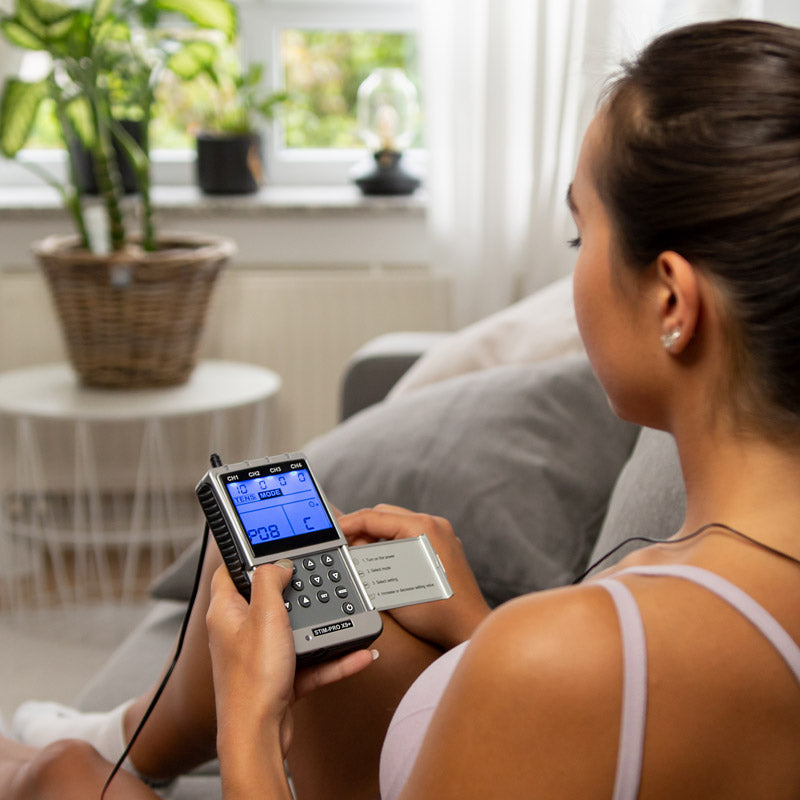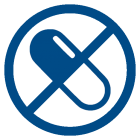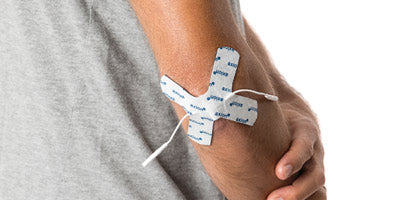TENS device applications

Pain-free thanks to electrical nerve stimulation - that is the promise of TENS therapy, which has already proven itself with a large number of users. With a compact TENS device, you can treat your pain from the comfort of your own home . Did you know that you can treat over 40 different types of pain all over the body with TENS?
The types of pain listed below take you directly to the respective application page including program recommendations and electrode placement .
You can use a TENS device for these types of pain
Please note:
TENS may not be performed in some situations. These contraindications include:
- cardiac arrhythmias
- Pregnancy (only with medical advice)
- Wearing a pacemaker
- Skin irritation, inflammation or open wounds at the intended location
- Metallic implants in the body (including copper spirals)
- mental illnesses
Do not place the electrodes on the neck or chest!
The correct electrode placement for a successful TENS treatment
The self-adhesive electrodes play the key role in every TENS treatment . They are the ones that transmit the current to the skin and into the nerve tracts.
Very positive effects can be achieved by using suitable electrodes. But only if they are placed correctly . TENS makes pain therapy on the entire body conceivable. In this respect, there are no limits with regard to the electrode position. You must not place the electrodes on the neck or chest! In the worst case, this can cause ventricular fibrillation due to the direct proximity to the heart.
Otherwise, the electrodes should always be placed where it hurts . Of course, you cannot know exactly where the nerve tracts or nerve fibers that are to be blocked are located. Therefore , several electrodes are usually placed around the painful area in order to reach all nerves.
Nevertheless, a little spirit of experimentation is also required: simply try out in several applications with different electrode placements where the effect is more noticeable and where it is not so noticeable. A small difference in placement can make a big difference in impact.
The correct electrodes themselves also make a difference. We offer a wide range of TENS electrodes that can help you relieve any type of pain. For example, for the back, you should use either multiple electrodes or a pad with a raised area.
To relieve back pain, you can use our Electrode Set for Back Pain . Pain caused by lumbago or in the area of the lumbar spine can be used with our large back electrode . You can use our electrode patch on rounded parts of the body such as joints. Above all, you can use it to relieve pain caused by arthritis or arthrosis. If you suffer from neck pain like about 30-50% of the adult population[5], our neck pain electrode will help you to relieve it.
Which programs do you use best for TENS?
Once you have chosen the electrode placement for the area to be treated and have stuck the electrodes on your skin, you are faced with the question of which program you should use for the best.
Our bestseller, the TENS EMS combination device STIM-PRO X9, has 16 different pre-installed TENS programs, which cover most types of pain. In the TENS application overview you can look around for a suitable type of pain and find out there the specific electrode placement and also the ideal program for the X9 and the other TENS devices from axion.
In addition to the pre-installed programs, it is also possible with the STIM-PRO X9 to set the parameters of the TENS treatment individually. This enables you, or the doctor or physiotherapist treating you, to adapt the TENS program specifically to your needs in order to maximize the effect of the pain therapy.
What are the experiences of TENS users?
Extremely positive .
Many users are very positive about TENS. Read the testimonials of customers who have already tried our TENS EMS combination device STIM-PRO X9 . There is often talk of quick effects – combined with a significantly higher quality of life . And also from a scientific point of view , there are many indications that the form of therapy with TENS can bring about a rapid and significant reduction in pain .
TENS devices, in conjunction with the correct electrode placement, can reduce pain in the back [1], shoulders [2] or arthritis [3]. In addition, several studies have also found that TENS increases blood flow in the muscles[4]. In addition, stimulation current has been used in clinics and medical practices for decades.
However, TENS is not a cure, just a form of pain treatment . The reason for this is simple: most pain has a deeper cause that needs to be repaired. Especially with a healthy and active lifestyle. TENS is often combined with electrical muscle stimulation (EMS), an artificially generated stimulation of the muscle. The muscle reacts as usual with a muscle contraction and consumes energy through the work done. In this way, the causes of pain can also be treated.
The advantages of pain treatment with TENS
-

From everywhere
You can use TENS therapy anywhere. It doesn't matter whether you're sitting comfortably on the sofa or in the office.
-

drug free
TENS pain therapy is an alternative to drug pain treatment
-

At any time
You can use TENS flexibly and at any time. Success can already be achieved after the first treatment
-

Free of side effects
When used correctly, pain treatment with TENS has practically no side effects
Studies and scientific sources
[1] Bertalanffy, A. (2005). Transcutaneous Electrical Nerve Stimulation Reduces Acute Low Back Pain during Emergency Transport. Academic Emergency Medicine, 12(7), 607-611. https://doi.org/10.1197/j.aem.2005.01.013
[2] Likar, R., Molnar, M., Pipam, W., Koppert, W., Quantschnigg, B., Disselhoff, B. & Sittl, R. (2001). Postoperative transcutaneous electrical nerve stimulation (TENS). The Pain, 15(3), 158-163. https://doi.org/10.1007/s004820170017
[3] Aiyejusunle CB, Kola-Korolo TA & Ajiboye OA (2007). Comparison of the effects of tens and sodium salicylate iontophoresis in the management of osteoarthritis of the knee. Nigerian Quarterly Journal of Hospital Medicine, 17(1). https://doi.org/10.4314/nqjhm.v17i1.12539
[4] Cramp, Gilsenan, Lowe & Walsh. (2000). The effect of high- and low-frequency transcutaneous electrical nerve stimulation upon cutaneous blood flow and skin temperature in healthy subjects. Clinical Physiology, 20(2), 150-157. https://doi.org/10.1046/j.1365-2281.2000.00240.x
[5] Neck pain. (2021, January 12). South German health insurance. https://www.sdk.de/news/suchartikel/nackenache/





